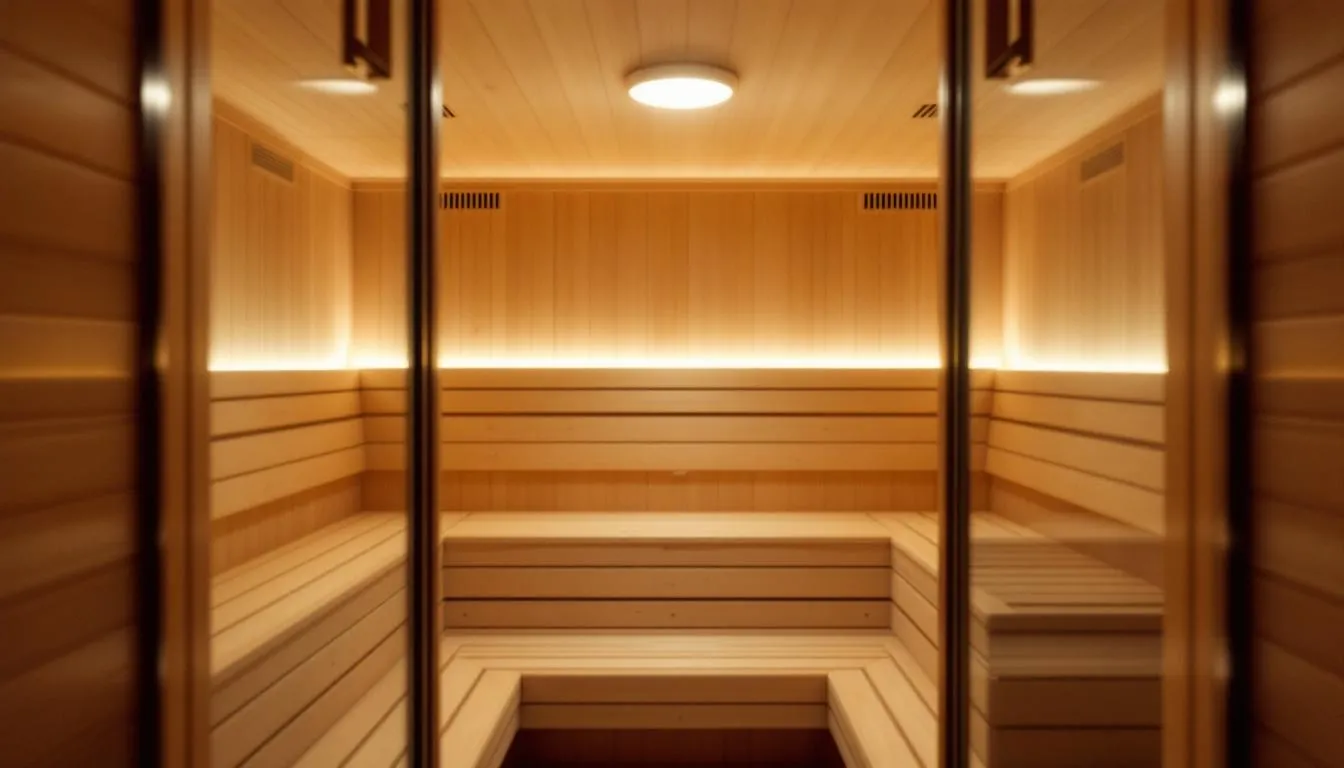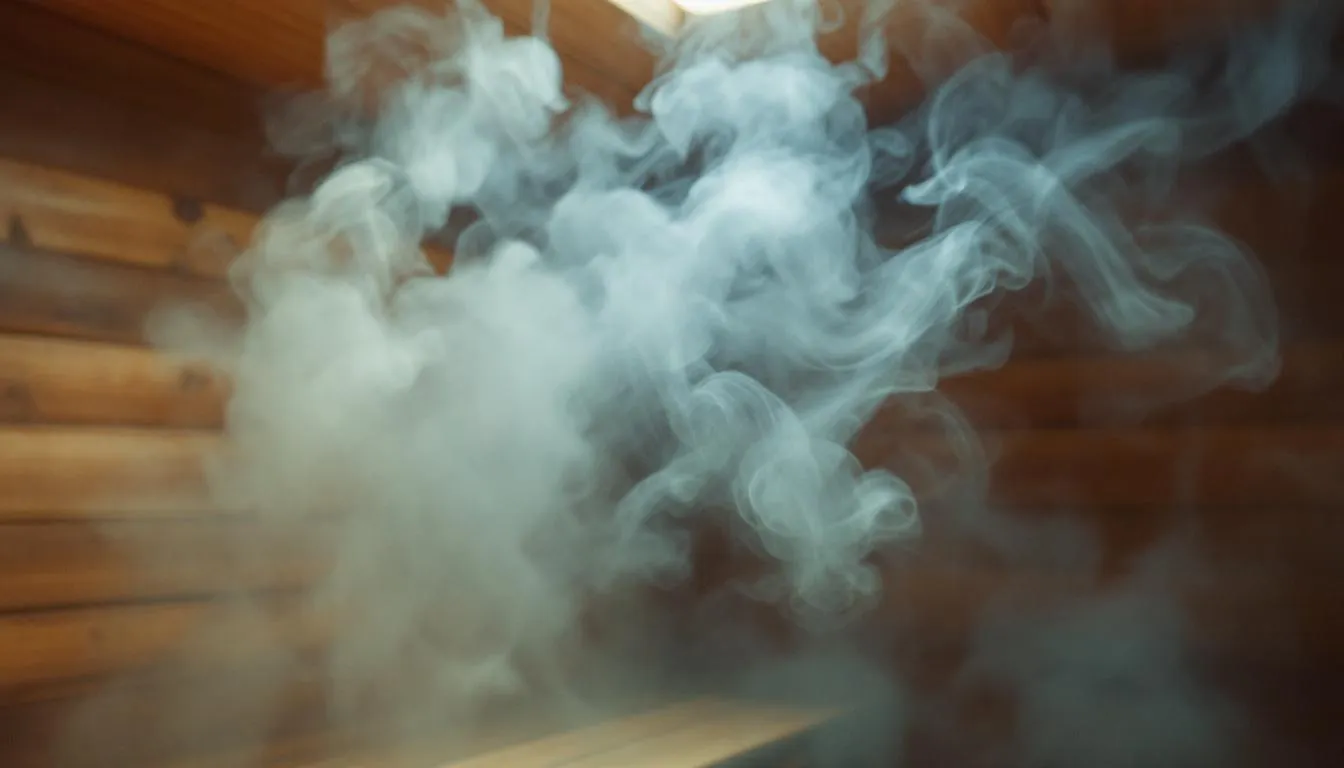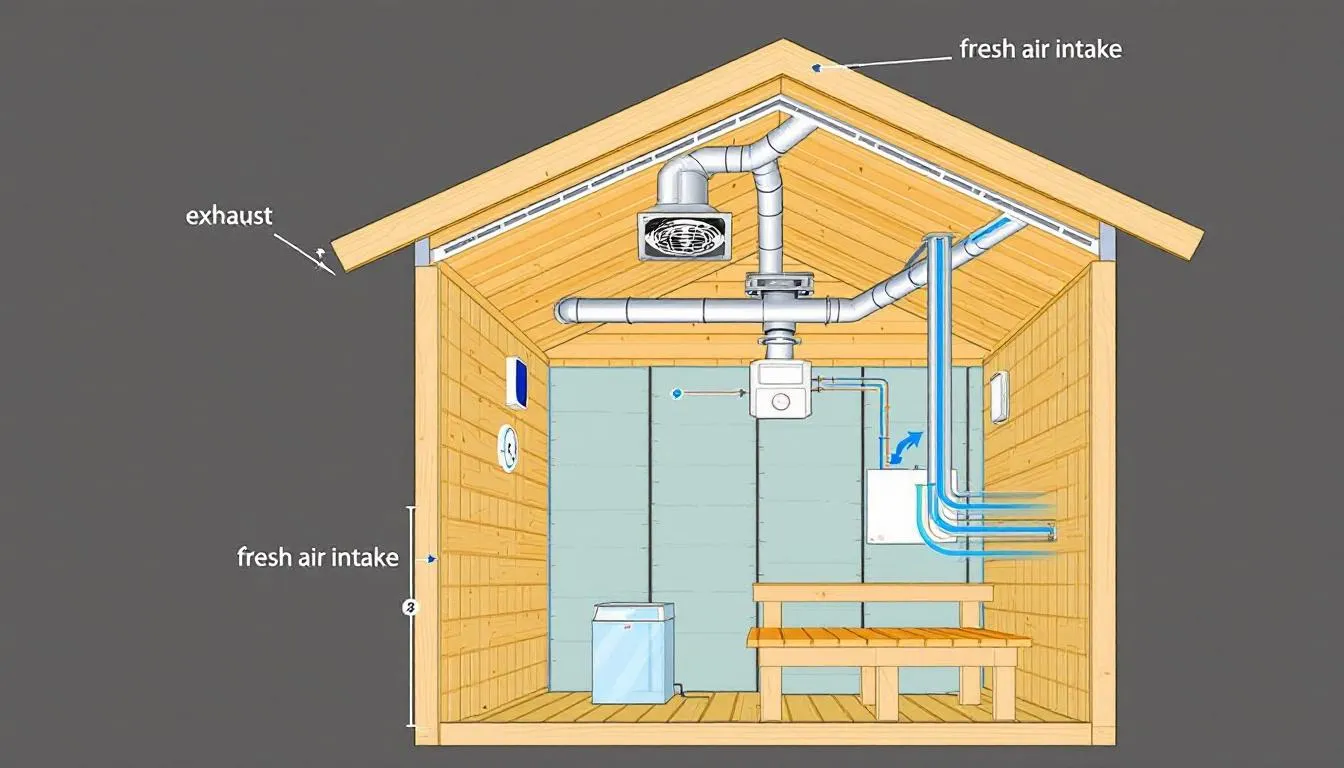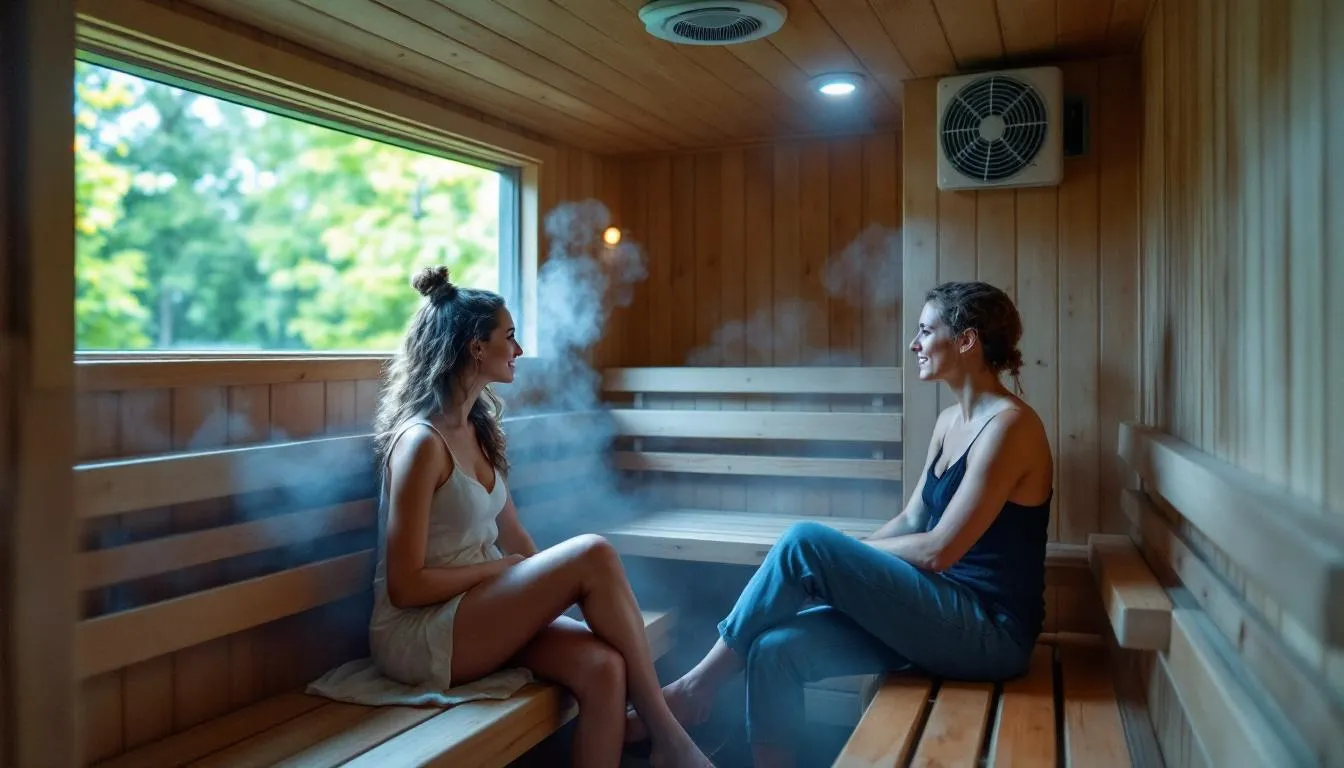Proper sauna ventilation ensures safe, breathable air and prevents health risks like dizziness and respiratory issues. It also protects the sauna structure from mold and mildew.
In this article, you'll learn why proper sauna ventilation is more important than it seems. We'll show you how to achieve it for optimal wellness.
Whether you're setting up a luxury home sauna or a basic model, ventilation is crucial for safety and comfort.
Key Takeaways
• Proper sauna ventilation is crucial for maintaining air quality, comfort, and safety by regulating CO₂ levels and preventing excessive humidity.
• The ventilation requirements differ between wood-fired and electric saunas, with the former needing more complex systems to manage smoke and humidity, while the latter typically has simpler needs.
• Common mistakes in sauna ventilation design include inadequate vent placement and sizing, which can lead to stale air and discomfort; following best practices is essential for optimal airflow.
What’s the Importance of Proper Sauna Ventilation?

At the heart of the best home sauna experience lies the need for proper sauna ventilation. The primary purposes of ventilation in a sauna are to remove excess CO₂, ensuring that the air remains fresh and breathable.
It also maintains comfort and safety by preventing CO₂ levels from rising, removes excess humidity, and replaces stale air with fresh air. Every sauna needs an effective system to achieve these ventilation goals.
Fresh air supply is essential for maintaining oxygen levels, which in turn prevents dizziness and enhances relaxation. When you breathe in clean, oxygen-rich air, your body can better handle the heat.
This makes your sauna sessions more enjoyable and effective. This is particularly important during longer sauna sessions, where maintaining a steady flow of fresh air can significantly impact your comfort and well-being.
Enhanced Sauna Experience Through Proper Airflow
Proper airflow enhances the overall sauna experience. A well-ventilated sauna ensures that the air flows smoothly, preventing the room from becoming stuffy or overly humid.
This not only enhances the comfort of users but also improves the effectiveness of the sauna in promoting relaxation and detoxification. In infrared saunas, proper ventilation maximizes benefits by ensuring optimal airflow, oxygen circulation, and humidity control.
For those wondering ‘how often should you use an infrared sauna?’, proper ventilation makes regular sessions safer and more comfortable. The infrared sauna benefits detox capabilities are enhanced when air quality is maintained at optimal levels.
A clean and well-ventilated environment in an infrared sauna is key to achieving desired wellness benefits. Important factors include optimal airflow to ensure even heat distribution, making the sauna session more comfortable and effective.
Maintaining CO₂ levels below 700 ppm, and ideally below 550 ppm, ensures good air quality and prevents adverse effects. Having a well-designed ventilation system keeps the air fresh and the environment safe.
Ready to experience the ultimate in home sauna wellness? Explore our collection of best home saunas to find the perfect fit for your needs.
Why Prioritize Sauna Ventilation?
Proper sauna ventilation is essential for both comfort and safety. One of the primary reasons to prioritize ventilation is to prevent the sauna from becoming overly hot or stuffy.
This can lead to discomfort and even health issues. Proper ventilation helps maintain a balanced sauna temperature, ensuring that the environment remains comfortable and conducive to relaxation.
Understanding what are the best home saunas means recognizing that proper ventilation is a key feature. The best infrared sauna for home use always includes adequate ventilation systems.
Maintaining Fresh Oxygen Flow and Reducing CO₂ Buildup
Another key reason is the maintenance of fresh oxygen flow and the reduction of carbon dioxide buildup. In a poorly ventilated sauna room, CO₂ levels can rise quickly.
This leads to dizziness, fatigue, and even more severe health risks. A steady supply of fresh air keeps oxygen levels high and CO₂ levels low, creating a healthier and more enjoyable environment.
Good ventilation also ensures that the air you inhale is clean and oxygen-rich. This is particularly important for individuals with respiratory conditions or allergies, as poor air quality can exacerbate their symptoms.
Prioritizing air ventilation creates a safer atmosphere with good air circulation for everyone. This applies whether you're considering a 1-person home sauna or larger multi-person unit.
Preventing Mold and Protecting Your Sauna Structure
Finally, proper ventilation reduces excess humidity, which is essential for preventing mold growth. It also maintains the integrity of the sauna building.
High humidity levels can lead to the development of mold and mildew. These not only pose health risks but also damage the sauna's structure over time.
By managing humidity levels through effective ventilation, you can prolong the life of your sauna. This ensures a healthier environment for users, regardless of the infrared sauna price point.
What’s the Ventilation Difference Between Infrared Sauna and Traditional Sauna?
The type of sauna heater you choose has a significant impact on the ventilation requirements of your sauna room. Understanding the infrared sauna vs traditional sauna differences is crucial for proper home sauna installation.
Whether you're considering the best infrared sauna for home or a traditional wood-fired option, ventilation plays a critical role in performance and safety. This also affects the overall 1-person home sauna cost when factoring in installation requirements.
Wood-Fired Saunas: Complex Ventilation Needs
Wood-fired saunas require careful ventilation to manage higher humidity levels. They also need to effectively vent smoke and gases.
The combustion process in wood-burning heaters produces smoke and gases that need to be vented out efficiently. This maintains a safe and comfortable environment.
This often involves complex ventilation systems designed to handle the smoke and humidity generated by the wood heater. Understanding these requirements is essential when choosing between different sauna types.
Electric Heated Saunas: Simplified Ventilation
In contrast, electric heated saunas generally do not require a venting system, as they do not produce smoke or gases. This allows for more consistent heat control and simpler ventilation needs.
Electric sauna heaters can maintain a steady temperature without the need to manage combustion byproducts. This makes them easier to operate and maintain.
However, proper air circulation is still essential to ensure a comfortable sauna experience.
The differences between wood-fired saunas and electric heated saunas extend to their overall ventilation needs. Wood-fired saunas require more complex systems to handle the smoke and humidity.
Meanwhile, electric saunas typically need simpler or no ventilation due to the absence of combustion emissions. This makes electric saunas a more convenient option for those looking for easier maintenance and operation.
However, both types of saunas benefit from good ventilation practices to ensure optimal comfort and safety.
Choosing between a wood-fired stove and an electric heater depends on your preferences and the specific requirements of your sauna project. While wood-fired saunas offer a traditional experience with a unique ambiance, they require more effort in terms of ventilation and maintenance.
On the other hand, electric heated saunas provide a more straightforward and consistent heating experience with simpler ventilation needs. Understanding these differences can help you make an informed decision.
This ensures that your sauna is both enjoyable and safe. Learn more about the best infrared saunas for your home.
How Does Poor Ventilation Affect Your Sauna Experience?
Poor ventilation can significantly detract from your sauna experience, leading to discomfort and potential health risks. High humidity levels in a poorly ventilated sauna can cause respiratory issues and discomfort.
This negates the potential infrared sauna health benefits of the sauna session. Without proper airflow, the sauna can feel stuffy and oppressive, making it less inviting and enjoyable.
When researching what are the best infrared saunas, ventilation quality should be a top consideration. Poor ventilation also impacts the benefits of infrared sauna for athletes who need optimal air quality during recovery sessions.
Recognizing Signs of Inadequate Ventilation
One of the most immediate effects of poor ventilation is the risk of dizziness and fatigue due to inadequate oxygen levels. Proper airflow is essential for maintaining adequate oxygen levels.
This in turn minimizes the risk of dizziness and fatigue. Signs of poor ventilation include stale air, excessive humidity, uneven heat distribution, and dizziness.
If you've ever felt lightheaded or overly tired after a sauna session, it could be due to insufficient ventilation. This is especially important for those wondering ‘which is better indoor or outdoor sauna?’
Stale air and unpleasant odors are common issues in a poorly ventilated sauna. Without sufficient air exchange, the sauna can become stale and less inviting for users.
This not only affects the comfort of the sauna experience but can also exacerbate existing respiratory conditions. It causes discomfort for individuals with asthma or allergies.
Mold Growth and Health Concerns
High levels of humidity combined with stagnant air can encourage mold and mildew growth, posing a health risk. Preventing the buildup of stale air and unpleasant odors through proper ventilation ensures a more pleasant and healthy environment.
This is particularly important for maintaining the integrity of the sauna building. It ensures the health and safety of its users.
Inadequate air circulation can also lead to increased perspiration and dehydration. If air circulation is inadequate, users can feel sick, dizzy, or nauseous.
This can make the sauna experience uncomfortable and potentially dangerous, especially for individuals with preexisting health conditions. Proper ventilation helps prevent these issues by ensuring a steady flow of fresh air.
It maintains a comfortable environment regardless of whether you have an outdoor infrared sauna or indoor model.
What Are the Benefits of Effective Ventilation in Your Sauna Room?

Effective ventilation in your sauna room offers numerous benefits that enhance both comfort and health. One of the primary advantages is the enhancement of the detoxification process during sauna sessions.
Ventilation systems that ensure fresh air circulation can enhance the detoxification process. This helps your body eliminate toxins more effectively.
This is especially important for those seeking the benefits of infrared sauna for athletes and fitness enthusiasts. Proper ventilation also maximizes the infrared sauna benefits detox that many users are looking for.
Improved Heat Retention and Distribution
Good ventilation in a sauna leads to improved heat retention, allowing for more efficient heating. Proper air circulation promotes balanced heat distribution.
This creates a sauna environment that feels hotter and more comfortable. It enhances therapeutic effects by ensuring every part of the sauna hot room is equally warm and inviting.
Maintaining balanced humidity levels is another significant benefit of proper ventilation. Balanced humidity levels from proper ventilation enhance overall sauna comfort.
This is particularly important for preventing the buildup of excess humidity. This can lead to mold growth and damage to the sauna structure, whether you have a 2-3-person home sauna or smaller unit.
Creating a Safer Sauna Environment
Effective ventilation also ensures a safer environment by preventing excessive carbon dioxide buildup. Adequate ventilation helps maintain a healthy sauna atmosphere by eliminating excess moisture.
It ensures that the air remains fresh and oxygen-rich. This reduces the likelihood of mold growth and promotes a healthier environment for sauna users.
This is true whether you have an infrared sauna 1-person unit or a larger model. For those considering best outdoor saunas, proper ventilation becomes even more critical.
In addition to these health benefits, proper ventilation helps maintain a more consistent and comfortable sauna temperature. This enhances the overall sauna experience.
A well-vented sauna can feel hotter due to the circulation of warm air across the body. This makes your sauna sessions more enjoyable and effective.
Interested in upgrading your wellness routine? Contact us today to learn about our best home sauna brands 2025 and find the perfect sauna for your home.
How Do You Optimize Air Flow in Your Sauna Hot Room?
Optimizing airflow in your sauna hot room is essential for creating a comfortable and effective sauna experience. A well-ventilated sauna creates a gentle airflow, making the space feel hotter than one with poor ventilation.
Hot air rises and can enhance the overall experience. This can be achieved through various ventilation strategies, such as using soffit vents and ridge vents in the sauna structure to facilitate air circulation.
This is important whether you're installing the best outdoor infrared sauna or indoor model.

Strategic Vent Placement for Optimal Airflow
Adding wall vents can allow for additional airflow and help prevent stale air accumulation in the sauna. Effective vent placement enhances airflow significantly.
Vents should ideally be installed at ear level when seated on the upper sauna bench. This placement ensures that air flows smoothly and evenly throughout the sauna hot room.
Proper vent placement prevents any areas from becoming overly hot or stuffy, including the lower vent and supply vents. This applies to both outdoor infrared vs indoor infrared sauna installations.
Leaving a gap of 10-15 cm at the bottom of the sauna door allows for better air circulation. It helps maintain a comfortable environment.
This simple yet effective tactic can significantly enhance the airflow in your sauna. It ensures that fresh air is consistently circulated throughout the space.
Maintaining Your Sauna's Ventilation System
Employing the 'Bake and Breathe' method can help maintain dryness in the sauna after use. This reduces the need for extensive cleaning.
In some cases, mechanical ventilation may be necessary to manage humidity effectively, especially during cold weather. This can involve the use of fans or exhaust systems to ensure that air flows smoothly and consistently.
It prevents any buildup of excess humidity or stale air. Understanding how to choose an outdoor sauna includes evaluating ventilation options.
Optimizing airflow in your sauna hot room creates a more comfortable experience. It allows cooler air, heated air, and outside air to circulate, making it more enjoyable.
See our collection for the best outdoor sauna options, including models.
Mechanical Ventilation vs. Natural Ventilation
When it comes to sauna ventilation, you have two primary options: mechanical ventilation and natural ventilation. Each has its own set of advantages and disadvantages.
Choosing the right one depends on your specific needs and preferences. This decision also impacts the overall home sauna installation process.
Understanding Mechanical Ventilation Systems
Mechanical ventilation systems utilize fans to circulate air, ensuring consistent airflow regardless of temperature changes. This can be particularly beneficial in environments where natural ventilation may not be sufficient.
One of the main advantages of mechanical ventilation is its ability to provide consistent and controlled airflow. A mechanical exhaust blower for electric heaters helps remove stale air from the sauna.
This ensures that the air remains fresh and oxygen-rich. However, one of the disadvantages is the potential noise from an electric fan, which might affect the relaxing atmosphere.
This is an important consideration if you value a quiet and serene sauna experience.
Exploring Natural Ventilation Methods
On the other hand, natural ventilation relies on temperature differences and static pressure changes to draw air in and out. This method can be less effective in tightly sealed spaces.
But when properly designed, it can maintain a more pleasant thermal environment without the need for mechanical systems. Properly designed natural ventilation can avoid the need for mechanical systems.
It can maintain a more pleasant thermal environment. However, poor design of natural ventilation can lead to stale air and discomfort for users.
It's essential to ensure that the ventilation system is adequately planned and executed to avoid these issues. In some cases, a combination of both natural and mechanical ventilation might be the best solution.
This provides the benefits of both systems while mitigating their respective drawbacks.
What Common Ventilation Mistakes to Avoid?
When designing and installing a sauna ventilation system, it's crucial to avoid common mistakes that can compromise effectiveness. One common error is overlooking the importance of vent placement.
Vent placement significantly influences air circulation and temperature gradients within the sauna. Proper placement ensures optimal airflow and prevents areas of stagnant air.
This is especially important when considering a weatherproof outdoor infrared sauna installation.
Critical Vent Placement Errors
Another common mistake is positioning the air intake too close to the heater door in wood-fired saunas. This can cause the air to escape without circulating properly.
This leads to inefficient ventilation and potential discomfort for users. Directing both intake and exhaust vents to the same environment ensures effective air exchange.
Failing to do so can lead to ineffective ventilation and a less comfortable sauna experience. These principles apply whether you're setting up a home sauna for sale unit or custom build.
Avoiding Inadequate Vent Sizing
Using vents of inadequate size can hinder airflow, which is essential for preventing stale air buildup in saunas. It's important to use vents that are appropriately sized for the sauna room.
This ensures sufficient air circulation. Avoid using a single low vent instead of a combination of lower and upper vents.
This can result in poor airflow and increased stuffiness. Use a combination of vents at different heights to promote better ventilation and a more comfortable environment.
By avoiding these common mistakes, you can ensure that your sauna ventilation system is effective. It contributes to a pleasant and healthy sauna experience.
Proper planning and execution are key to achieving good ventilation and maximizing the benefits of your sauna.
What Are the Best Practices for Home Sauna Installation?
Installing an effective sauna ventilation system requires careful planning and consideration of various factors. One of the best practices is to consider the type of stove and whether it uses gravity-based or mechanical ventilation.
This should come from a reputable stove manufacturer. The design of the ventilation system should align with the type of heater selected to ensure proper air exchange and optimal performance.
Understanding what are the most popular infrared saunas for home use helps you make informed ventilation decisions. Consider the infrared sauna price and installation costs when planning your project.

Professional Installation Guidelines
Using a combination of soffit vents and ridge vents can effectively manage air circulation in sauna structures. This approach helps promote consistent airflow and prevents the buildup of excess humidity and stale air.
Additionally, ensuring a gap of 10-15 cm at the bottom of the sauna door can enhance air circulation. It contributes to a more comfortable environment.
Proper wall vent installation is also crucial for effective ventilation. Wall vents should be installed to allow for airflow, contrary to the misconception that they should be kept closed.
Consulting a professional when planning or installing a mechanical ventilation system is advisable. This ensures proper setup and avoids potential issues, especially when considering outdoor infrared sauna warranty and materials.
Professional home infrared sauna installation ensures optimal performance and longevity.
Optimizing Your Ventilation System Configuration
To promote efficient air movement, install the exhaust air pipe on the opposite wall from the stove. This helps draw air through the sauna room.
Position the drying pipe away from the heat source. Place it preferably in the sauna ceiling or high on the wall to maintain a comfortable environment.
Effective ventilation not only improves air quality but also plays a crucial role in ensuring the longevity of sauna materials. It minimizes moisture damage.
Following these best practices creates a well-ventilated sauna, offering a comfortable, safe, and enjoyable experience for users. Discover our range of solutions, including luxury home sauna options for your needs.
Summary
In summary, proper sauna ventilation is essential for ensuring a safe, comfortable, and enjoyable sauna experience. It involves removing excess CO₂, maintaining fresh air supply, and preventing humidity buildup.
Key reasons to prioritize sauna ventilation include preventing discomfort, maintaining oxygen levels, and reducing the risk of mold growth. Understanding the differences between wood-fired and electric heated saunas can help you choose the right ventilation system for your needs.
Effective ventilation enhances the detoxification process, improves heat retention, and promotes balanced heat distribution. It also prevents excessive CO₂ buildup and reduces the likelihood of mold growth.
Optimizing airflow through proper vent placement, the use of soffit and ridge vents, and mechanical ventilation can significantly improve the sauna experience. By avoiding common mistakes and following best practices, you can ensure that your sauna is well-ventilated and provides maximum benefits.
Ready to transform your home with a premium sauna? Visit HomeSauna.com today to explore our complete collection and find the perfect sauna for your wellness journey.
Frequently Asked Questions About Sauna Ventilation
Are Home Saunas Safe for Health?
Yes, home saunas are safe for health when properly installed and ventilated. Proper ventilation ensures fresh oxygen circulation, prevents CO₂ buildup, and maintains comfortable humidity levels.
This creates a safe environment that promotes wellness benefits like improved circulation, stress relief, and detoxification. Most health concerns arise from poor ventilation, which can be easily addressed by following proper installation guidelines.
Regular maintenance and monitoring of air quality further enhance safety. Whether you choose a 1-person home sauna or larger model, proper ventilation is key to maximizing infrared sauna health benefits.
What Are the Best Home Saunas Available Today?
The best home saunas available today include both traditional and infrared sauna models from reputable brands. Top-rated options feature advanced heating technology, proper ventilation systems, and durable construction.
Look for full-spectrum infrared sauna models that offer comprehensive therapeutic benefits with near, mid, and far infrared wavelengths. The best choices combine effective ventilation design with quality materials and user-friendly controls.
Consider factors like size, heating method, ventilation requirements, and warranty when selecting from best home sauna brands 2025. Professional installation ensures optimal performance and safety for years to come.
Do You Need Ventilation in a Sauna?
Ventilation is essential in a sauna to ensure fresh air circulation, prevent stale conditions, and maintain the integrity of the structure. Proper ventilation enhances hygiene and overall user experience by removing excess CO₂.
It also manages humidity levels and prevents mold growth. Without adequate ventilation, users may experience dizziness, fatigue, or respiratory discomfort.
Both traditional and infrared saunas benefit from proper ventilation systems, though the specific requirements may differ based on the heating method. Good home sauna installation practices always include proper ventilation planning.
How Often Should You Use an Infrared Sauna?
For optimal health benefits, most people can safely use an infrared sauna 3-4 times per week for 20-30 minutes per session. Beginners should start with shorter sessions of 10-15 minutes and gradually increase duration as their body adapts.
Proper ventilation during each session is crucial to maintain air quality and maximize infrared sauna benefits detox. Athletes or those seeking specific therapeutic benefits may use infrared saunas more frequently, even daily.
The benefits of infrared sauna for athletes include improved recovery and reduced inflammation. Always ensure adequate hydration and listen to your body's responses.
Why Is Ventilation Important in a Sauna?
Ventilation is crucial in a sauna to prevent the accumulation of harmful gases like carbon monoxide and carbon dioxide. These can pose serious health risks.
Proper airflow ensures a safe and enjoyable experience while maintaining desired heat levels. Good ventilation also manages humidity levels, prevents mold growth, and ensures consistent temperature distribution throughout the sauna space.
It enhances the therapeutic effects by ensuring users breathe clean, oxygen-rich air. This is essential for the relaxation and health benefits associated with sauna use, whether you have an outdoor infrared sauna or indoor model.
How Does Poor Ventilation Affect the Sauna Experience?
Poor ventilation significantly diminishes the sauna experience by causing discomfort and potential health risks such as respiratory issues and dizziness. Without adequate airflow, CO₂ levels rise, oxygen levels drop, and humidity becomes excessive.
This creates a stuffy and uncomfortable environment. This can lead to headaches, nausea, and shortened sauna sessions.
Poor ventilation also promotes mold growth, creates unpleasant odors, and can damage the sauna structure over time. Ensuring proper airflow is essential for maintaining optimal air quality and a safe, enjoyable sauna environment.
Which Is Better: Indoor or Outdoor Sauna?
The choice between indoor or outdoor sauna depends on your space, budget, and preferences. Indoor saunas offer convenience, year-round accessibility, and easier climate control.
This makes them ideal for consistent use. Outdoor infrared sauna models provide a natural setting, more ventilation options, and don't take up interior space.
Consider outdoor infrared vs indoor infrared sauna factors like installation complexity, weatherproofing needs, and maintenance requirements. Indoor saunas typically have simpler ventilation needs.
Meanwhile, outdoor models may benefit from natural airflow but require weather-resistant construction. Both can provide excellent wellness benefits with proper installation and ventilation.
What Are the Differences Between Wood-Fired and Electric Saunas in Terms of Ventilation?
Wood-fired saunas necessitate complex ventilation systems to manage smoke and humidity from the combustion process. These systems must effectively vent smoke, gases, and excess moisture while maintaining proper air circulation.
Electric saunas, including best infrared sauna for home models, generally require simpler or no ventilation due to the lack of combustion emissions. This makes them easier to install and maintain.
Electric saunas rely primarily on managing humidity and ensuring adequate air exchange for comfort. The choice between them depends on your preference for traditional ambiance versus convenience and simplified maintenance requirements.
